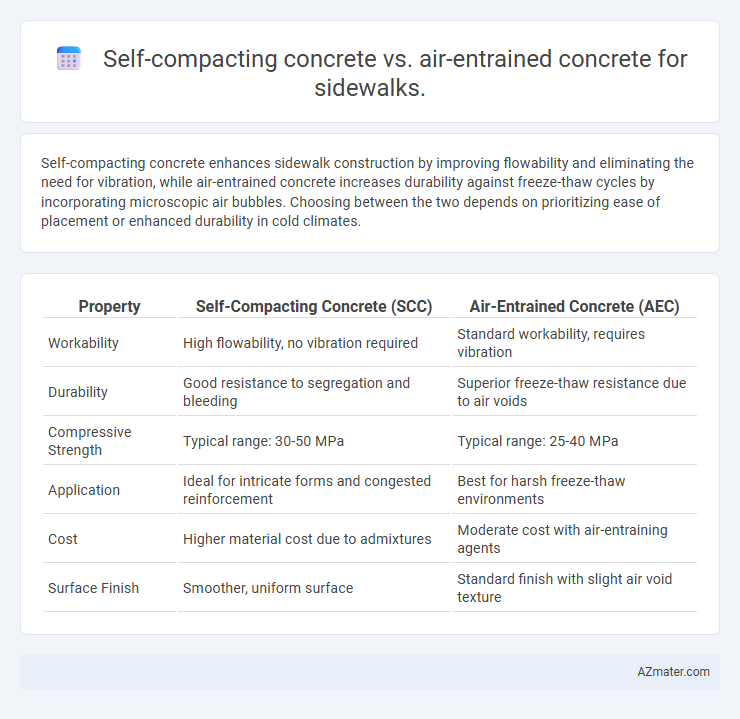Self-compacting concrete enhances sidewalk construction by improving flowability and eliminating the need for vibration, while air-entrained concrete increases durability against freeze-thaw cycles by incorporating microscopic air bubbles. Choosing between the two depends on prioritizing ease of placement or enhanced durability in cold climates.
Table of Comparison
| Property | Self-Compacting Concrete (SCC) | Air-Entrained Concrete (AEC) |
|---|---|---|
| Workability | High flowability, no vibration required | Standard workability, requires vibration |
| Durability | Good resistance to segregation and bleeding | Superior freeze-thaw resistance due to air voids |
| Compressive Strength | Typical range: 30-50 MPa | Typical range: 25-40 MPa |
| Application | Ideal for intricate forms and congested reinforcement | Best for harsh freeze-thaw environments |
| Cost | Higher material cost due to admixtures | Moderate cost with air-entraining agents |
| Surface Finish | Smoother, uniform surface | Standard finish with slight air void texture |
Introduction to Specialized Concrete for Sidewalks
Self-compacting concrete (SCC) offers superior flowability and consolidation without mechanical vibration, making it ideal for complex sidewalk forms and dense reinforcement areas. Air-entrained concrete incorporates microscopic air bubbles to enhance freeze-thaw durability, essential for sidewalks exposed to harsh weather conditions. Selecting between SCC and air-entrained concrete depends on the required workability, durability against environmental stresses, and long-term maintenance considerations.
Overview: Self-Compacting Concrete (SCC)
Self-compacting concrete (SCC) is a highly flowable, non-segregating concrete that can spread into place and encapsulate reinforcement without mechanical consolidation, making it ideal for complex sidewalk forms and tight spaces. Its superior workability improves surface finish quality and reduces labor costs compared to conventional and air-entrained concrete, which relies on entrapped air to enhance freeze-thaw durability. SCC's optimized mix design, with increased fines and chemical admixtures, ensures uniformity and durability in pedestrian pavement applications, delivering a smoother, more durable sidewalk surface.
Overview: Air-Entrained Concrete
Air-entrained concrete incorporates microscopic air bubbles that enhance durability and resistance to freeze-thaw cycles, making it ideal for sidewalks exposed to harsh weather conditions. This type of concrete improves workability while reducing surface scaling and cracking caused by freeze-induced expansion. Its superior frost resistance extends the lifespan of sidewalks in climates experiencing frequent temperature fluctuations.
Workability and Placement Methods
Self-compacting concrete (SCC) offers superior workability with its high flowability and ability to fill complex forms without mechanical vibration, making placement on sidewalks faster and smoother. Air-entrained concrete incorporates microscopic air bubbles to improve freeze-thaw durability but requires conventional vibration for proper consolidation, potentially slowing placement. SCC's self-leveling properties reduce labor and ensure uniform surface finish, while air-entrained concrete prioritizes durability in cold climates at the expense of ease of placement.
Durability and Longevity in Sidewalk Applications
Self-compacting concrete (SCC) offers superior durability in sidewalk applications due to its high flowability and dense microstructure, reducing voids and enhancing resistance to cracking and freeze-thaw cycles. Air-entrained concrete incorporates microscopic air bubbles that improve freeze-thaw resistance and durability in cold climates by preventing internal pressure buildup during freezing. For long-lasting sidewalks, SCC provides better uniformity and reduced permeability, while air-entrained concrete excels in environments prone to deicing salts and cyclic freezing conditions.
Freeze-Thaw Resistance Comparison
Self-compacting concrete (SCC) offers superior workability and uniformity, reducing voids but typically lacks inherent freeze-thaw resistance unless air-entrainment is incorporated. Air-entrained concrete contains microscopic air bubbles specifically designed to accommodate water expansion during freeze-thaw cycles, significantly enhancing durability for sidewalks in cold climates. Comparatively, air-entrained concrete demonstrates better resistance to freeze-thaw damage, reducing scaling and surface deterioration more effectively than standard SCC without air entrainment.
Surface Finish and Aesthetic Outcomes
Self-compacting concrete (SCC) offers a smooth, uniform surface finish ideal for sidewalks, eliminating the need for mechanical vibration and reducing the risk of surface defects. Air-entrained concrete improves frost resistance and durability but may result in a slightly rougher texture, affecting the aesthetic uniformity of the sidewalk surface. The superior flowability of SCC ensures enhanced visual appeal with consistent surface quality compared to the textured finish typical of air-entrained mixtures.
Cost Implications and Economic Analysis
Self-compacting concrete (SCC) typically incurs higher initial costs due to specialized admixtures and mix designs, but it reduces labor and formwork expenses by eliminating the need for vibration, leading to potential overall savings in sidewalk construction. Air-entrained concrete, while generally less expensive upfront, offers improved durability and freeze-thaw resistance beneficial for sidewalks in cold climates, potentially lowering long-term maintenance and repair costs. Economic analysis favors SCC in complex or labor-intensive projects where speed and finish quality reduce total project time and cost, whereas air-entrained concrete remains cost-effective in standard sidewalk applications with significant exposure to freeze-thaw cycles.
Sustainability and Environmental Impact
Self-compacting concrete (SCC) reduces construction waste and energy consumption by eliminating the need for mechanical vibration, enhancing sustainability through lower carbon emissions. Air-entrained concrete improves durability by increasing resistance to freeze-thaw cycles, reducing maintenance frequency and resource use over the sidewalk's lifespan. Both types contribute to environmental impact reduction, with SCC offering material efficiency and air-entrained concrete promoting long-term structural integrity.
Selecting the Best Concrete Type for Sidewalk Projects
Self-compacting concrete enhances sidewalk construction by offering superior flowability and consolidation without mechanical vibration, reducing labor costs and ensuring uniform surface finish. Air-entrained concrete provides increased durability against freeze-thaw cycles through microscopic air bubbles that prevent cracking in cold climates. Selecting the best concrete type depends on project-specific factors such as climate, desired durability, construction speed, and budget considerations.

Infographic: Self-compacting concrete vs Air-entrained concrete for Sidewalk
 azmater.com
azmater.com